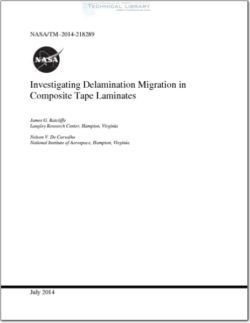NASA-TM-2014-218289

- Version
- 200 Downloads
- 2.70 MB File Size
- 1 File Count
- April 21, 2016 Create Date
- April 21, 2016 Last Updated
Investigating Delamination Migration in Composite Tape Laminates

A modification to a recently developed test specimen designed to investigate migration of a
delamination between neighboring ply interfaces in tape laminates is presented. The specimen
is a cross-ply laminated beam consisting of 40 plies with a polytetrafluoroethylene insert
spanning part way along its length. The insert is located between a lower 0-degree ply
(specimen length direction) and a stack of four 90-degree plies (specimen width direction).
The modification involved a stacking sequence that promotes stable delamination growth prior to
migration, and included a relocation of the insert from the specimen midplane to the interface
between plies 14 and 15. Specimens were clamped at both ends onto a rigid baseplate and
loaded on their upper surface via a piano hinge assembly, resulting in a predominantly flexural
loading condition. Tests were conducted with the load-application point positioned at various
locations along a spec/men’s span. This position affected the sequence of damage events
during a test. Delamination growth occurred prior to migration in specimens loaded at a location
near to and ahead of the insert front. Conversely, delamination migration occurred first in
specimens loaded at a position further behind the insert front. In the former cases, variation of
the load-application location was found to affect the distance relative to this point at which
migration initiated. Migration initiated in each specimen by a gradual transition of the
delamination at the 0/90 interface into the 90-degree ply stack. In contrast, transition into the
new 90/0 interface was sudden. A delamination resistance mechanism was observed that arose
from delamination actually delving slightly into the lower 0-degree ply prior to migration. This
implies that such an effect may be present during delamination at a non-unidirectional ply
interface in any laminates subjected to flexural loading.
Delamination is a failure mode commonly associated with composite tape laminates, and
has thus received considerable attention focused on delamination as an individual mode of
failure. For instance, considerable effort has been paid toward characterizing individual
delamination, driven under mode-l, mode-ll, mode-Ill and a mixture of these loading conditions
[1-4]. Meanwhile, analysis methods have been developed that simulate delamination onset and
growth along one ply interface without the possibility for migration of that delamination to
another interface [5, 6]. While such analyses are adequate in many situations, delamination
growth in laminates commonly involves migration between different ply interfaces [7-10].
| File | Action |
|---|---|
| NASA-TM-2014-218289 Investigating Delamination Migration in Composite Tape Laminates.pdf | Download |

Comment On This Post